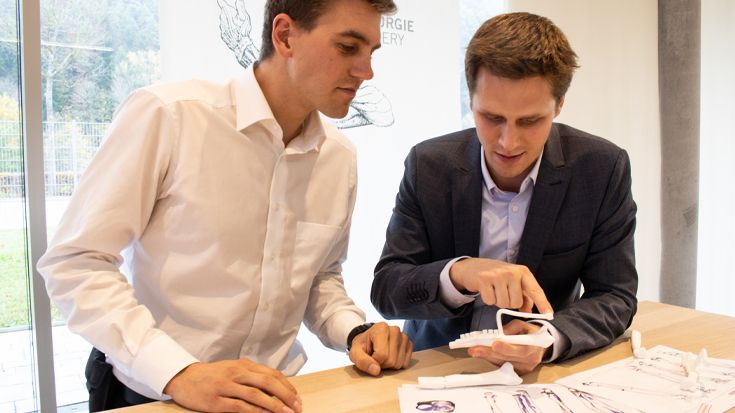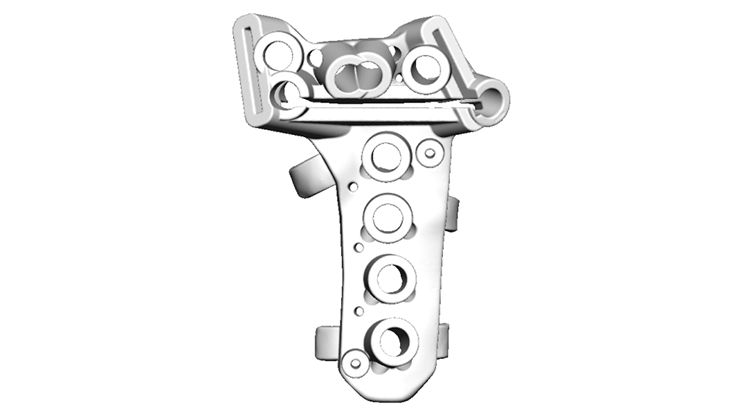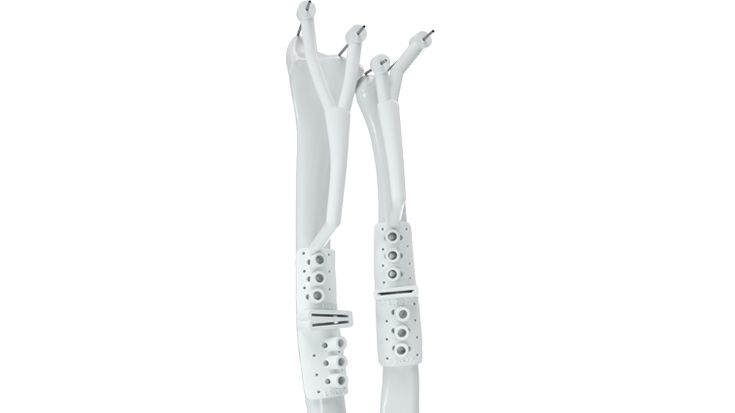1. What is IPS Implants® Hand about?

IPS Implants® Hand includes patient-specific reconstruction of the distal radius and forearm (radius and/or ulna). Once a CT scan has been made of the affected region and the other, healthy side of the patient, a case can be created in the IPS Gate® and the data uploaded. One of our engineers then plans and constructs the reconstruction in close cooperation with the surgeon. Afterwards, depending on the indication and clinical situation, one or more drill and marking guides, patient-specific implants, and pre- and post-operative models are planned and produced. These are later used intraoperatively to achieve the previously planned digital reconstruction.
2. For which indications and cases are our solutions suitable?
Our solutions can be used to treat a wide range of indications in hand surgery. Currently, IPS Implants® Hand is mainly used for patients with limited mobility and pain following trauma to the distal radius and/or forearm due to a malpositioned fracture. IPS Implants® Hand is often used to correct a stressful and restrictive situation for the patient that occurred a long time ago.
3. What are the advantages for patients and users?
The main advantage of patient-specific radius and forearm reconstruction is the precise anatomical reconstruction of bone and joint surfaces. The mishealed side is compared with the healthy opposite side and with this reference then correctly aligned.
Users and patients can benefit from the IPS® technology in hand surgery, especially in forearm reconstructions and complex extra- or intra-articular radius reconstructions. Particularly noteworthy are cases in which rotational malpositions are present in the forearm or the joint surface of the distal radius has to be reconstructed in a complex manner. The preoperative, virtual 3D planning, the drill and marking guides as well as the patient-specific implants support the surgeon intraoperatively. Particularly noteworthy is the 3D-printed patient-specific implant, which brings the bone segments exactly into the previously planned optimal anatomical position and fits perfectly to the bony structures.
4. When was the first patient treated with this technique and how many cases have been realized since then?
The first patient-specific extraarticular distal radius reconstruction was performed by Dr. med. Stephan F. Schindele, Schulthess clinic in Zurich, Switzerland, in March 2016. This marked the start of a study with 6 patients, which was presented at the FESSH Congress 2018 in Copenhagen.
In October 2018, the first two patient-specific forearm reconstructions were performed in collaboration with Dr. med. Antti Launonen at the University Hospital Tampere, Finland and Dr. med. Jan Ragnar Haugstvedt at the Østfold Hospital, Moss, Norway.
After patient-specific extra-articular distal radius reconstruction and patient-specific forearm reconstruction had established themselves as the first IPS Implants® Hand indications, the first intra-articular radius reconstructions with IPS Implants® Hand were performed in June and July 2019 in collaboration with Dr. med. Philip Grieve, MD, at the Blackrock Clinic, Dublin, Ireland, Dr. med. Niels Schep in Maasstad Ziekenhuis Rotterdam, Netherlands, and Dr. med. Radek Kebrle in Vysoke nad Jizerou Hospital, Czech Republic.
To date, 52 patients have benefited from IPS Implants® Radius Reconstruction and 23 from IPS Implants® Forearm Reconstruction. A further 32 cases are currently being planned.
5. What is the first feedback on the product?
The feedback from users who work with our IPS® Hand technology is consistently positive. Together with the users, we continue to try to continuously improve and further develop our IPS® technology in hand surgery. In addition to the positive surgical results, we also receive a lot of positive feedback for the close and open cooperation with the users.
"The 3-dimensional reconstruction of fractures of the forearm that have healed in a deformed position has meanwhile proven its worth at various centers and good results have been reported in the literature for this still young technique to this day. This technique increases the precision of the correction on the one hand and shortens the duration of the operation on the other hand. Especially in complex reconstructions with rotational malpositions the use of this technique is indispensable. The fixation of the correction with an individual implant also in many cases does justice to the individual anatomy in each case." - Dr. med. Stephan F. Schindele, Schulthess Clinic, Zurich, Switzerland
"After many years as a hand surgeon, one of the most challenging procedures to perform is correction of malunited forearm fractures that the patient suffered from in childhood. Using 3D reconstruction of the contralateral (non-injured) arm, and patient-specific guides and plates, the correction has been made “easy” with good results and happy patients." - Dr. Jan-Ragnar Haugstvedt, Østfold Hospital, Moss, Norway
"With regards to the case in question, I simply wouldn't have been able to treat this complex intra-articular malunion effectively without a patient specific implant and the 3D planning involved. On the day of surgery the support KLS Martin provided was top class and ensured the surgery was performed to the highest standard possible. I'm looking forward to my next case already." - Dr. med. Philip Grieve, Blackrock Clinic, Dublin, Ireland
"IPS® provides me with the tools to plan and execute complex extra-articular malunions of the distal radius. Moreover, recently we also successfully completed intra-articular corrections with the help of patient-specific 3D-printed guides and titanium plates." - Dr. med. Niels Schep, Maasstad Ziekenhuis Rotterdam, Netherlands
"3D planning and customized 3D printing in reconstructive surgery starts to be an inevitable solution for certain pathologies. Their use during reconstruction of intra-articular malunions of the distal radius gives us a chance to reconstruct more complex cases that would be otherwise indicated for salvage." - MUDr. Radek Kebrle, Vysoke nad Jizerou Hospital, Czech Republic
6. How have the products developed in collaboration with clinical users?
Since the first use of IPS® in hand surgery in 2016, the design of the drill and marking guides as well as the design of the patient-specific plates have continuously evolved.

In radius reconstruction, the guide has been made slimmer, more anatomical and thus more minimally invasive, while maintaining the required stability of the guide. Marking guides with several saw cuts have also been used to date. Furthermore, in special cases, the sawing gap of the guide can be replaced by K-wire holes if desired by the user. The required osteotomy is then performed with K-wires and then with small bone chisels instead of a saw blade, which means that less bone substance is lost and precision is increased. This is particularly helpful in intra-articular malpositions.
If possible, we also try to combine several saw cuts for extra- or intra-articular radius reconstructions in one guide. Depending on the complexity of the case or at the surgeon's request, several guides for drilling and osteotomies can also be planned and used.

Particularly noteworthy is our special design of the drill and marking guides for patient-specific forearm reconstructions. We have successively developed the drill and marking guides based on user feedback. The compact, original design of the guide was additionally equipped with a distal arm including K-wire holder, which contributes to the precise positioning of the jig. In the current and latest design of the guide, the distal end of the guide arm represents a Y, which fixes two pre-planned reference points with two K-wires, simplifying and ensuring the precise positioning of the guide.
Since it is very difficult to precisely position the drill and marking guide in the area of the forearm, our special design offers the surgeon great added value intraoperatively and for achieving the planned end result.
7. What will come in the future? What will be possible in the future?
In cooperation with clinical users, we plan to make patient-specific care in hand surgery accessible to even more patients by further simplifying the workflow. The IPS® technology will increasingly represent an important treatment option in the future, especially for complex cases, since the systematic approach makes it possible to check the clinical results and thus ensure quality assurance.
At the same time, we plan to expand our patient-specific indications in hand surgery. In addition to extra- and intra-articular radius reconstruction and forearm reconstruction, projects for IPS® solutions in the reconstruction of metacarpal bone and scaphoid bone are also planned in the future.